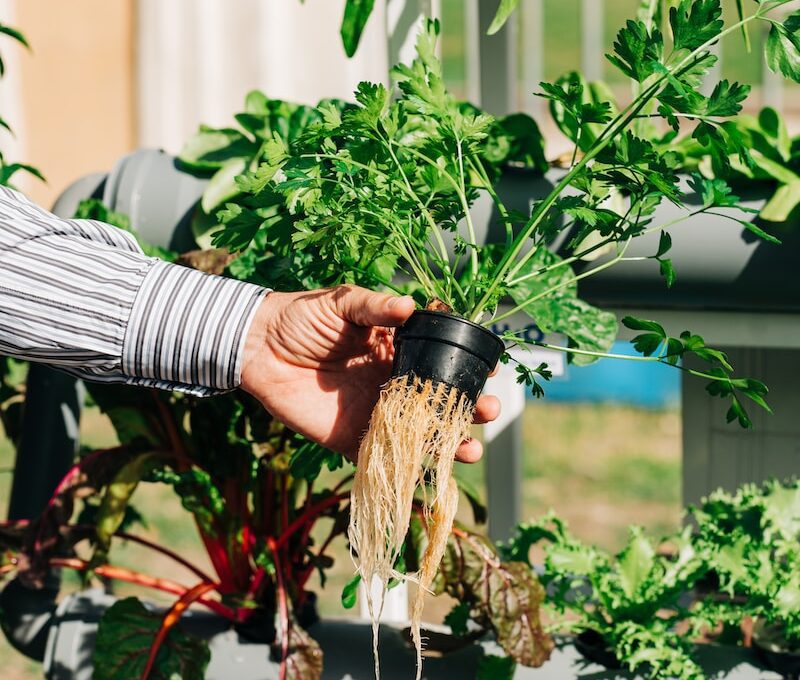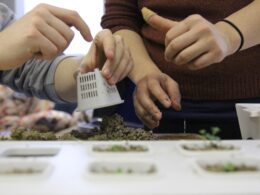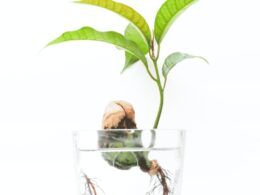Are you new to hydroponics and wondering how long it takes for your plants to grow? This method of growing plants without soil has been gaining popularity due to its efficiency and ability to produce high yields. However, the growth rate of your plants can depend on various factors, such as the type of plant, environment, and nutrient levels.
In this article, we will explore the factors that affect hydroponic growth rates and provide a general timeline for common plants. Understanding the plant life cycle is crucial to maximizing growth rates, and we’ll give you tips on how to achieve this.
We’ll also discuss common issues that may arise during the growth process and how to troubleshoot them. By the end of this article, you’ll have a better understanding of how long it takes for hydroponic plants to grow and the steps you can take to ensure their optimal growth.
Factors that Affect Hydroponic Growth Rates
One key factor in hydroponic growth rates is the environment in which the plants are grown. The pH balance of the water and nutrient solution is crucial for optimal growth. If the pH level is too high or too low, the plants won’t be able to absorb the necessary nutrients and will experience stunted growth. It’s important to regularly monitor the pH level and adjust it as needed to maintain a balanced environment for your plants.
Another important factor is the lighting intensity. Plants require different levels of light depending on their species and growth stage. Providing the correct amount of light can significantly increase the growth rate of your plants. However, too much or too little light can be harmful. It’s important to research the lighting needs of your specific plant and adjust the intensity accordingly.
In addition to pH balance and lighting intensity, there are other environmental factors that can affect hydroponic growth rates, such as temperature, humidity, and air flow. It’s important to create a stable and consistent environment for your plants to thrive. By monitoring and adjusting these factors, you can ensure optimal growth and a successful hydroponic harvest.
General Timeline for Common Plants
Discover the ideal timeline for popular plants grown through hydroponics, so you can enjoy fresh, nutrient-rich produce in no time. The expected yield and harvest frequency for hydroponically grown plants depend on several factors such as the type of plant, lighting, temperature, and nutrient levels. However, some general timelines can help you plan and monitor the growth of your hydroponic garden.
For leafy greens such as lettuce, spinach, and kale, the expected yield can range from 15 to 25 ounces per square foot. These plants can be harvested continuously as soon as they reach maturity, which is usually between 20 to 40 days after planting. You can expect to harvest your leafy greens every one to two weeks, depending on the growth rate and your preferred harvest frequency.
For fruiting plants such as tomatoes, peppers, and strawberries, the expected yield can range from 10 to 20 ounces per square foot. These plants take longer to reach maturity, usually between 60 to 90 days after planting. Once the plants start producing fruit, you can expect to harvest them every one to two weeks, depending on the growth rate and the ripening time of the fruit.
With these general timelines, you can plan your hydroponic garden and enjoy a regular supply of fresh, healthy produce.
Understanding Plant Life Cycles
By understanding the life cycles of plants, you can better plan and optimize your hydroponic garden to ensure a consistent and healthy yield. The stages of plant growth can be divided into four main phases: germination, vegetative growth, flowering, and fruiting.
Each phase requires specific nutrients, lighting, and environmental conditions to ensure successful growth. Here are the four plant growth stages and what they entail:
-
Germination: This is the stage where the seed begins to sprout, and the tiny roots and shoot emerge from the seed. At this stage, the plant requires high humidity and warm temperatures to encourage growth.
-
Vegetative growth: This stage is characterized by rapid growth of the plant’s leaves, stems, and roots. Vegetative growth requires high levels of nitrogen, phosphorus, and potassium, as well as appropriate hydroponic lighting.
-
Flowering: During this stage, the plant produces flowers, which will eventually turn into fruit. Flowering requires a change in the hydroponic lighting schedule to encourage the plant to produce flowers.
-
Fruiting: This is the final stage of plant growth, where the plant produces fruit. Fruiting requires a high level of potassium and phosphorus, and appropriate hydroponic lighting to ensure successful growth.
Understanding the different stages of plant growth and their requirements can help you optimize your hydroponic garden to ensure a consistent and healthy yield. By providing the right nutrients, lighting, and environmental conditions, you can help your plants grow and flourish.
What Techniques Can I Use to Speed Up My Hydroponic Growth?
There are several effective techniques for speeding up hydroponic growth. First, optimizing the nutrient solution by maintaining the appropriate pH level and nutrient balance is crucial. Additionally, providing ample light to the plants, either through natural sunlight or artificial grow lights, promotes faster growth. Implementing regular pruning and trimming helps redirect energy towards new growth, ultimately accelerating the overall growth rate. Lastly, ensuring proper air circulation, humidity levels, and temperature control in the growing environment contribute to faster hydroponic growth.
Tips for Maximizing Growth Rates
To ensure your hydroponic garden flourishes, all you need is to follow these tips for maximizing growth rates and witness the magic happen right before your eyes. One of the most important factors in hydroponic growth is lighting requirements. Plants need a lot of light to grow, and in hydroponic systems, they rely entirely on artificial lighting. It is recommended to use high-intensity discharge (HID) lights for hydroponic gardens, as they provide the necessary light intensity for plants to thrive.
Another key factor in maximizing growth rates in hydroponic gardens is pH balance. In soil-based gardens, soil acts as a buffer to maintain a steady pH level. However, in hydroponic systems, water is the medium, and it is important to monitor and adjust the pH level regularly. The optimal pH range for most plants is between 5.5 and 6.5. Use a pH meter to test the pH level of your water regularly and adjust it accordingly using pH up or pH down solutions.
In addition to lighting and pH balance, there are other ways to maximize growth rates in hydroponic gardens. Providing adequate air circulation, controlling temperature and humidity levels, and ensuring proper nutrient levels are all essential for healthy plant growth. By following these tips and monitoring your hydroponic garden regularly, you can achieve rapid growth rates and a bountiful harvest in no time.
| Lighting | pH Balance | Air Circulation | Nutrient Levels |
|---|---|---|---|
| Use HID lights | Optimal pH range: 5.5-6.5 | Provide adequate air circulation | Ensure proper nutrient levels |
| High-intensity discharge (HID) lights provide necessary light intensity for growth | Monitor and adjust pH level regularly | Control temperature and humidity levels | Use hydroponic-specific nutrient solutions |
| Provide at least 12-16 hours of light per day | Use pH up or pH down solutions to adjust pH level | Install fans or ventilation systems for proper air flow | Avoid over-fertilization, which can damage plants |
Troubleshooting Common Issues
If you’re experiencing problems with your hydroponic system, it could be due to nutrient deficiencies, pests and diseases, overcrowding, or algae growth.
Nutrient deficiencies can lead to stunted growth and yellowing leaves, while pests and diseases can quickly spread and damage your plants.
Overcrowding can cause competition for resources and hinder growth, while algae growth can block light and nutrients from reaching your plants.
Keep an eye out for these common issues and take proactive measures to prevent or address them.
Nutrient deficiencies
Identifying and addressing nutrient deficiencies in your hydroponic setup can mean the difference between a thriving garden and a lackluster one. Preventing nutrient deficiencies begins with understanding the symptoms associated with different deficiencies. Here are a few things to keep in mind:
- Nitrogen deficiency: Look for yellowing leaves, stunted growth, and weak stems.
- Potassium deficiency: Check for brown spots on leaves, weak stems, and slow growth.
- Calcium deficiency: Watch out for distorted leaves, root rot, and slow growth.
Once you’ve identified the deficiency, it’s important to adjust your nutrient solution accordingly. This may mean adding more of a specific nutrient or adjusting the pH of your solution.
It’s also important to check your water quality as well. By taking these steps, you’ll be able to keep your hydroponic setup healthy and thriving.
Remember, nutrient deficiencies can happen to anyone, but by staying vigilant and proactive, you’ll be able to keep your hydroponic garden in top shape. Keep an eye out for any symptoms and adjust your nutrient solution accordingly. With a little bit of attention and care, you’ll be able to grow healthy and bountiful plants in no time.
Pests and diseases
Now that you know about nutrient deficiencies, it’s important to also be aware of pests and diseases that can affect your hydroponic plants. These can include spider mites, aphids, and fungal infections.
Dealing with pests and diseases can be frustrating, but there are prevention methods and treatment options to help you keep your plants healthy. Prevention is key when it comes to pests and diseases. Make sure to keep your hydroponic system clean and sterile, and avoid introducing any contaminated materials or plants. You can also use natural pest repellents such as neem oil or insecticidal soap.
If you do notice signs of pests or diseases, it’s important to act quickly. There are various treatment options available, such as using beneficial insects, applying fungicides, or removing affected plants. By staying vigilant and taking proactive measures, you can help ensure a successful hydroponic harvest.
Overcrowding
Let’s talk about how overcrowding can affect the health and growth of your hydroponic plants. Maximizing yield is a common goal for most hydroponic gardeners, but it’s important to remember that plants need space to thrive. When plants are too close to each other, they compete for resources like light, water, and nutrients. This can lead to stunted growth, weaker plants, and lower yields.
Here are some examples of how overcrowding can negatively impact your hydroponic garden:
- Your plants may become stressed and susceptible to pests and diseases.
- Crowded roots can lead to poor nutrient absorption and root rot.
- Overcrowding can create a humid environment that encourages fungal growth.
To avoid these problems, it’s important to practice space optimization in your hydroponic garden. This means giving each plant enough room to grow and avoiding the temptation to cram in as many plants as possible.
By spacing your plants appropriately, you can maximize your yield and ensure that each plant has the resources it needs to flourish. Remember, healthy plants are happy plants!
Algae growth
Algae growth can be a major issue in hydroponic systems, affecting not only the aesthetics of your plants but also their overall health and productivity. Algae can thrive in hydroponic systems due to the high nutrient levels and constant water supply. This can lead to a number of problems such as clogged pumps, reduced oxygen levels, and nutrient imbalances. To prevent algae growth, it is important to maintain a clean and sterile environment, monitor nutrient levels, and use appropriate lighting.
One way to prevent algae growth is to ensure that your hydroponic system is properly sterilized before use. This includes cleaning all surfaces, equipment, and nutrient solutions with a disinfectant. Additionally, you can use UV sterilizers or other products specifically designed to prevent algae growth. Another important factor to consider is lighting requirements. Algae require light to grow, so it is important to choose a hydroponic lighting system that does not promote algae growth. This can include using LED grow lights or adjusting the intensity and duration of light exposure. By taking these steps, you can prevent algae growth and ensure that your hydroponic system remains healthy and productive.
| Algae Prevention | Lighting Requirements | ||
|---|---|---|---|
| Clean and sterilize all surfaces, equipment, and nutrient solutions | Choose a hydroponic lighting system that does not promote algae growth | ||
| Use UV sterilizers or other products specifically designed to prevent algae growth | Consider using LED grow lights | ||
| Monitor nutrient levels | Adjust the intensity and duration of light exposure | Regularly clean and maintain the hydroponic system to prevent the buildup of organic matter that can contribute to algae growth. |
Frequently Asked Questions
What are the best types of plants to grow using hydroponics?
If you’re looking to start a hydroponic garden, you’ll be pleased to know that there are many top hydroponic crops to choose from!
Some of the best types of plants to grow using hydroponics include leafy greens like lettuce and spinach, as well as herbs like basil and cilantro.
Other popular options include tomatoes, cucumbers, and peppers.
One of the major benefits of hydroponic farming is that it allows you to grow these crops quickly and efficiently, without the need for soil or traditional farming methods.
This can be especially appealing to those who are concerned about food safety and want to know exactly where their produce is coming from.
So if you’re looking to get started with hydroponics, consider trying some of these top crops and enjoy the many benefits of this innovative farming method!
Can hydroponics be used for growing plants outdoors?
Hydroponics isn’t just for indoor gardening – you can use it for outdoor gardening too! In fact, hydroponics has several benefits over traditional soil gardening.
For one, you don’t need to worry about weeding or soil-borne diseases. Plus, hydroponic plants grow faster and yield more than their soil-grown counterparts.
With hydroponics, you can also control the nutrients and pH levels of your plants’ environment, ensuring they get exactly what they need to thrive. So give hydroponics a try for your outdoor gardening needs and see just how much easier and more efficient it can be!
What are the initial costs associated with setting up a hydroponic system?
If you’re considering setting up a hydroponic system, it’s important to consider the initial costs associated with this method of gardening. The initial investment can vary depending on the size of your system, the type of plants you want to grow, and the equipment you need.
To start, you’ll need to budget for items such as grow lights, nutrient solution, containers, pumps, and a pH meter. It’s also crucial to conduct an ROI analysis to determine how long it will take to recoup your investment.
When planning your budget, it’s important to take into account sustainability considerations such as energy usage and water consumption. Additionally, maintenance expenses such as replacing equipment and purchasing new nutrients should be factored in.
With careful planning and budgeting, a hydroponic system can be a cost-effective and sustainable way to grow plants.
Is it possible to grow medicinal herbs using hydroponics?
If you’re looking to grow medicinal herbs, hydroponics can be a fantastic option. The benefits of hydroponic herb farming are numerous. You can experience faster growth rates, higher yields, and more control over growing conditions.
When comparing hydroponics vs soil for medicinal plants, hydroponics often comes out on top. This is due to its ability to provide consistent nutrient delivery and prevent soil-borne diseases. With hydroponics, you don’t have to worry about the hassle of soil maintenance.
Overall, if you’re interested in growing medicinal herbs, hydroponics can be an efficient and effective way to do so.
How often should nutrient solutions be changed in a hydroponic system?
To maintain healthy plant growth in a hydroponic system, it’s important to pay attention to the nutrient solution. The frequency of changing the nutrient solution depends on the composition of the solution and the type of plants being grown. Generally, the solution should be changed every one to two weeks.
The composition of the solution should contain all the necessary nutrients required by the plants. These include nitrogen, phosphorus, potassium, calcium, magnesium, and trace elements. It’s important to monitor the pH level of the solution as well, as it can affect nutrient uptake.
By regularly changing and monitoring the nutrient solution, you can ensure your plants are getting the nutrients they need to grow healthy and strong.
Conclusion
Congratulations on completing your journey into the world of hydroponics! You now have a better understanding of the factors that affect growth rates, the general timeline for common plants, and how to maximize growth rates.
Remember that plant life cycles vary, so it’s important to research the specific needs of your plants. To ensure success, always monitor your plants closely and troubleshoot any common issues that may arise.
By following these tips and utilizing the benefits of hydroponics, you can enjoy the satisfaction of growing your own fresh produce in a shorter amount of time than traditional soil-based gardening. Happy growing!









